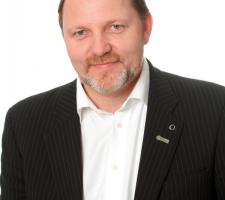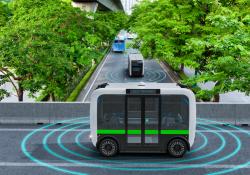
Are pre-launch trials of charging systems the way to improve public acceptance? Or is the real key a more robust political attitude? Here, leading system suppliers discuss the issue
The use of distance-based Road User Charging (RUC) is now well established, at least for heavy goods vehicles on strategic roads. However demand management for all vehicles, whether a distance-based charge or some form of cordon scheme, has yet to make significant progress. This is in spite of the logic and equity of RUC being easy to understand.Around the world, charging scheme after charging scheme has failed to gain that key to progress - a 'Yes' vote - often as a result of local politicians' parochial self-interest. Citizens' antipathy to RUC is habitually assumed by policymakers and there seems to be a reluctance to engage in a concerted and meaningful campaign to change public opinion.
Demonstration of the concept of charging is seen by many as one possible way of improving levels of support, however the realities of that are challenging to say the least - it effectively means constructing a charging and enforcement scheme in the face of the very real risk that it may have to be dismantled and removed only a very short time later. Technology choice, and the amounts of infrastructure needed, has a role to play and proponents of satellite (GPS/GNSS)-based systems point to its infrastructure-light nature. Some have also suggested the use of mobile telephony as a means of simulating a scheme and its effects ahead of construction and operation. But are demonstrations, even those with minimal infrastructure, a realistic proposition?
Bounced into orbit
Good demonstrations integrate users, increase the acceptance and allow customer-specific testing, says"For urban centres a satellite (GNSS/GPS)-based tolling system is the best solution as this technology requires almost no infrastructure and so causes the least disturbance to the cityscape.
"But rather than approximating the service to be introduced using a non-permanent installation, for example cellular telephony or some other means, the decision should be taken for a long-term and stable system which is available to users all the time. The toll road of the future will in any case be 'virtual', without roadside infrastructure. The cost of constructing an infrastructure-based system is too high for large toll charging systems. Depending on business rules and legislation, the OBU will be equipped with several sensors such as GNSS and gyroscopes. The toll amount will be calculated autonomously and transmitted via the cellular network or alternative communication methods to the back office. There is no interaction required with any roadside infrastructure."
Necessary evils
Congestion doesn't just arise, notes Q-Free's Steinar Furan. People travel by car because they need to get somewhere. However it is possible to improve acceptance levels."The use of congestion charging to improve traffic conditions in cities is typically unpopular and politically controversial. Still, citizens aren't stupid and experience shows that when charging is put into the right context there is acceptance.
"The charging debate has probably focused too much on the toolbox; rather than discussing the problem - congestion - and the corresponding solution, the conversation often turns into one about satellite tolling, OnBoard Units [OBUs] or Automatic Number Plate Reading [ANPR]. Privacy, technical problems and fee structures become the issue and the real focus is lost. This doesn't encourage support.
"The solution must focus on the demand for transportation and how this can be solved by other means than private vehicles. Citizens need to see that, rather than being just an additional tax, congestion charging improves their daily lives.
"A plan to combat congestion has to present alternative means of transportation to the public, encouraging the use of the desired means of travel and discouraging the use of others. Using the profit from congestion charging to finance improvements to the desired means creates positive feedback. Stockholm improved and expanded public transportation services prior to the introduction of the congestion tax system. This was the key to solving congestion. The charging scheme was merely a catalyst for change in demand. Stockholm now benefits from a comprehensive programme where the income from the congestion tax finances more and more projects to improve public transport accessibility and services.
"So, how could more cities experience the success of Stockholm? Firstly, the solution must take into consideration the total demand for transport services. Every city is unique. Once alternatives to private transport are in place, a congestion charge can be introduced and the choice of technology can be debated. Most importantly, a congestion charging system has to generate funds at a rate capable of financing local public transport initiatives. And it must show a profit margin so that the public feels that the charges paid serve a useful purpose. It does matter if the cost of the charging operation consumes 15 or 30 per cent of the revenue. This is often neglected during the design of congestion charging systems.
"There are currently three tools in the congestion charging toolbox: ANPR, DSRC [Dedicated Short-Range Communication] OBUs and readers and GNSS. While the last has often been praised as the 'ultimate solution' practical experience shows that it is not very well suited for congestion charging. Cities will still need to build an enforcement infrastructure and they have many areas where satellite signals are either disturbed or blocked. ANPR or ANPR in combination with DSRC often gives very efficient solutions for congestion charging, as enforcement comes as a part of the charging system and the cost of deployment is comparatively low. This is for instance the case for Stockholm, where an ANPR system is used to identify all vehicles crossing the congestion tax zone as well as to provide legal evidence when a car owner refuses to pay. This system has proven to work as desired and also to provide significant funding for the city. By looking at the process leading up to the implementation of the Stockholm congestion tax system, other cities can also achieve the same results with the consent of their citizens."
Stockholm - a false premise
But it's just not possible to use the Stockholm scheme as an example in this context, according to"Stockholm was a real implementation that was subject to a referendum, was stopped for a while and then reinstated after a 'Yes' vote. When putting the issue to a vote, we need to understand who is being asked what. The Stockholm referendum was very close, with those living in the city saying one thing and those living in the surrounding region saying another.
"Against this background, it's not possible to generalise that trial schemes are becoming a prerequisite; it could be argued that voting at the next election against a politician who has introduced a policy that you do not agree with is the same as a referendum. That was the view taken by London and Ken Livingstone.
"The decision over a trial and the need for a permanent installation has to be taken in light of local political and cultural considerations. There are more consensus-oriented countries like those in Scandinavia but there are also countries where referendums have no tradition and trials are not expected by the population. In the latter it's much more important that the responsible politicians are able to make clear, sometimes unpopular decisions and then see them through. Most importantly, the affected people need to be informed in detail about the need for a scheme, its implications and effects. If that's done, no further trials are needed.
"Also, what is a 'meaningful demonstration'? Is it really possible to demonstrate the technology and effects without having the final scheme in place? "The question of technology depends heavily on what should be achieved by the trial. If a trial is to be convincing, it's probably necessary to establish a situation which is very similar to a real charging scheme and the trial period needs to be long enough to provide meaningful results. Most probably, the use of the same technology which is also planned for the final implementation makes best sense.
"At this point another argument against extensive trials arises: if they are only meaningful if they totally reflect the final scheme, their costs are also similar. I'd question whether many municipalities nowadays have the money to spare.
"With regard to the choice of the technology, the same rules apply as for every charging scheme: different technologies are possible and the answer to which best suits depends on a number of assumptions which differ from city to city. Trials around the world have demonstrated technology, successfully - and to death, some may say, but this is only one component of a charging scheme, it's the operational and business processes that are the critical components of any scheme.
"Charging schemes using private mobile phones are always difficult because of enforcement. How can we be sure that the device stays in the car? This is probably also a privacy issue.
"Nevertheless, a tolling simulation using cellular telephony can make sense if the mobile device is for example used as a display in addition to another very simple GPS device for the real toll detection which would stay in the car permanently. The display could then be used to inform the user about tariffs and amounts due. Applications with a positive connotation could be running on the phone to create added value for users.
"Satellic Traffic Management has already developed and successfully demonstrated a smart tolling application that can easily be downloaded to a mobile device. There needs to be caution when considering consumer devices rather than automotive-grade products, though, as the reliability and performance of any device is critical to any scheme.
"Technology choice will always depend on a scheme's objectives. The combination of a booking system with ANPR enforcement seems to be the current favourite for city tolling schemes because it is cost-effective to implement. If charges are dependent upon distance travelled, it may be more cost-effective to implement a GNSS-based solution in areas for schemes with big, complex road networks and many entries and exits. Singapore, for example, is currently planning a GNSS trial to prepare for replacement of its current system. Canyoning is an issue for GNSS-based systems but is overcome with additional tools such as map matching. It is also true that GNSS technologies are improving significantly and this trend will continue. The core GNSS products are already very much commodity products.
"There is another factor that is pushing GNSS as a possible technology for city tolling schemes: in countries with existing satellite-based tolling schemes on their strategic road networks, extending these into cities would be relatively straightforward and new parts can be integrated swiftly and with flexible tariffing schemes."
Uniformity of approach
People may not appreciate the charge itself but they will appreciate the consequences of it, says"In all, the result is a more livable city but if public education only extends to how the charge is raised, where to register and pay, and the penalty structure, then people will not like the outlook. It is a bitter pill: people have to change their behaviour. If they want to save cost they have to shift to public transport or avoid travelling. This is perceived as a loss of freedom or mobility. Commuting will cost a little more, the school run with the car will be questioned and so on. Maybe polluting vehicles will have to be updated. These are exactly the behavioral changes the municipality wants to achieve.
"Demonstrations come into the game here. They remove fuzzy thinking and show that a municipality wants to take serious steps to improve matters. Stockholm showed that one part of the improvement is difficult to explain: some traffic simply disappeared, which is a part of any successful introduction of congestion charging.
"A meaningful demonstration is not technology-dependent, in the sense that it is reliant upon user friendliness and measurable, quantifiable improvements in the daily commute. Of course this implies technology; people will ask questions, they need to know how complicated - or simple - daily use will be. They want to know what happens to their personal data and whether a system is fair.
"There is another implication in the long run: the service will have to be familiar, much like that of neighbouring cities. Drivers are ready to accept variance of pricing but not to be forced to use a stack of different OBUs and operating procedures.
"Approximation needs to have the same associations as the ultimate solution. Actual charging needs to be applied to generate the impact and improvement of mobility; you can talk about different phases but not systems '1' and '2'. The demonstration should therefore make use of the technology to be implemented, as too much variance is confusing to the public. Still, the purpose of the demonstrator is to convince the people of the benefits, to communicate local transport policy to them and to create 'experienced' and amenable users; it is not there to prove technical feasibility or user perceptions. The demonstrator stages can be used to find the optimal charging rates.
"So a demo cannot be too shallow, and user perception and ease of use are paramount. ANPR provides a solution with no effort to the vehicles or users. From one day to another the scheme is there but it is associated with high operational costs. DSRC provides the most cost-efficient method of detection and collection but requires some effort and interaction with users and their vehicles so is not always preferable politically. Other solutions suffer from much higher capital costs - GNSS-based systems due to significantly more expensive OBUs and communication costs - or higher leakage rates - sticker vignettes. Therefore the evolution is possibly dependent on application of multiple technologies. This will require a model that brings together stakeholders in a valid business case based on open interfaces and non-propriety technology.
"This might become difficult as one of the inhibiting forces in this context is the requirement of accredited services and hardware for charging: toll operators may not want to abandon income due a system reliability that is typically low for commercial off-the-shelf products or because system resources are eaten up by other applications besides charging.
"In the case of consumer products, such devices become expensive if attempts are made to render them tamper-proof. Finally, vendors of such products may not want to be associated with something that is seen as a fiscal rip-off. At the moment we're not seeing municipalities coming together to build up a common understanding of services, harmonised schemes, interoperability, clearing, legal constraints and, consequentially, technology."














